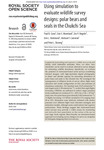Using simulation to evaluate wildlife survey designs
| dc.contributor.author | Conn, Paul B. | en_US |
| dc.contributor.author | Moreland, Erin E. | en_US |
| dc.contributor.author | Regehr, Eric V. | en_US |
| dc.date.accessioned | 2016-10-11T05:37:22Z | |
| dc.date.available | 2016-10-11T05:37:22Z | |
| dc.date.issued | 2016 | en_US |
| dc.identifier.other | HPU4160684 | en_US |
| dc.identifier.uri | https://lib.hpu.edu.vn/handle/123456789/23576 | en_US |
| dc.description.abstract | Logistically demanding and expensive wildlife surveys should ideally yield defensible estimates. Here, we show how simulation can be used to evaluate alternative survey designs for estimating wildlife abundance. Specifically, we evaluate the potential of instrument-based aerial surveys (combining infrared imagery with high-resolution digital photography to detect and identify species) for estimating abundance of polar bears and seals in the Chukchi Sea. We investigate the consequences of different levels of survey effort, flight track allocation and model configuration on bias and precision of abundance estimators. | en_US |
| dc.format.extent | 17 p. | en_US |
| dc.format.mimetype | application/pdf | en_US |
| dc.language.iso | en | en_US |
| dc.subject | Biology | en_US |
| dc.subject | Ecology | en_US |
| dc.subject | Aerial survey | en_US |
| dc.subject | Animal abundance | en_US |
| dc.subject | Ice-associated seal | en_US |
| dc.subject | Polar bear | en_US |
| dc.subject | Species distributionmodel | en_US |
| dc.subject | Survey design | en_US |
| dc.title | Using simulation to evaluate wildlife survey designs | en_US |
| dc.type | Article | en_US |
| dc.size | 1.22MB | en_US |
| dc.department | Education | en_US |
Files in this item
This item appears in the following Collection(s)
-
Education [806]

